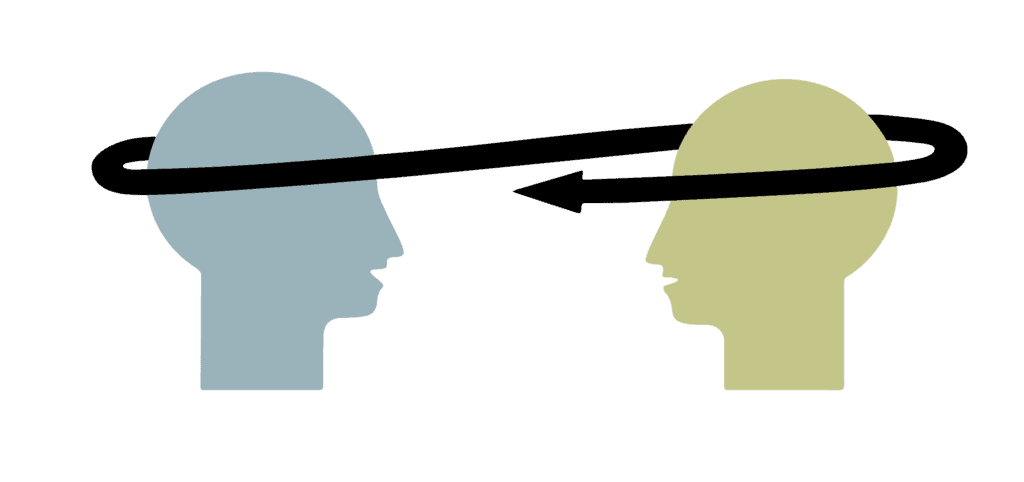Harvard research has shown that 2 months after listening to a talk, the average listener remembers only about 25% of what was said. In fact, we forget one half to one third of what we have learned within just 8 hours!
So, what’s going on? Why are we so bad at remembering?
What’s going on is a gap in our training. We’re simply not trained to listen.
In our early years, learning by reading is the focus of our education, with very little to no attention placed on learning by listening. Thus, as adults, we often face serious obstacles in listening.
But we don’t have to just accept this fate! Listening is critical to the success of our relationships (business or otherwise), and so today I’ve pulled together 6 common listening distractions we can overcome for greater productivity in all areas of our lives.
The Vital Role of the Listener
In the act of storytelling, there is a reciprocal relationship between the listener and the teller. The listener plays a vital role in the transfer of ideas and information. And, when the listener does their job, it shows the speaker that their intelligence is valued and the speaker is more likely to share ideas.
Narativ’s founder, Murray Nossel, PhD, writes in this article: “Leaders who acknowledge that no telling can take place without listening, and that listener and teller play equal roles in the dynamic of listening and telling draw maximum value from conversations at work, whether report-outs or in team meetings. Listening is critical to being productive.”
Obstacle Showdown
Since I know that listening is so crucial, I’ve made a conscious effort to improve my own listening skills. As part of this, I addressed some common listening obstacles in my recent Obstacle Showdown video series. Over a period of 6 weeks, I paid close attention to my personal obstacles and identified one per week, documenting their effect on my listening. Take a look at the listening obstacles I discovered in myself to see if you struggle with any of the same:
Obstacle #1: News Headlines
Whether it’s local, national, or global, news headlines can become distracting—and it’s often difficult not to be bothered by them. I found that my mind would consistently wander to and worry about news headlines when I wanted to be focused on listening to coworkers and family members.
The solution? Clearing my listening.
At Narativ, clearing your listening is a technique used to be more present. Set aside your to-do list, news headlines, or your own story and actively listen to those around you in order to create connections and transmit ideas.
Obstacle #2: External Noise
External noise is often something you can’t control, especially when so many of us are still working from home. Noise from your family, spouse, roommates, or coworkers can be distracting (it most definitely is for me!), distancing you from the storyteller and making it harder to be a good listener.
The solution? Identifying the problem.
Oftentimes, simply identifying and acknowledging the issue of external noise helps reduce it as a distraction. As you become more aware of yourself, you can turn down the volume outside and hone your listening.
Obstacle #3: Making A Choice
I discovered this obstacle as I was preparing for a workshop. I needed a story to help me teach; however, as I gathered stories and experiences from my life, I realized I would have to make a choice—which made me question which story would make the cut. Judging and evaluating arguments took the focus away from my mind, my story, and started to disconnect me from the audience I was about to interact with.
The solution? Gratitude.
Releasing the judgements on each story gave way to a flood of gratitude for each life experience. I recognized the value of each story, halting the distracting arguments in my head while clearing my mind to make a choice. I entered the workshop feeling grateful for this new audience and it allowed me to connect more genuinely with them.
Obstacle #4: Construction Work
Similar to external noise we discussed in #2, one day I found myself distracted by the noise of construction work happening outside my house. And, once again, this noise was something over which I had no control.
The solution? Working around their schedule.
I learned the schedule of the construction work and did my best to work around it, eliminating the distracting noise. Though this isn’t always possible, when you can take action to reduce distraction, you enable yourself to be present and focus on listening.
Obstacle #5: Physical Pain
During this week’s obstacle showdown, I had an old injury flare up, which caused physical pain for several days. When you’re in pain (or even hungry or tired), it’s hard to focus on anything outside yourself, but you need to be present for others when you’re listening.
The solution? Take time to recover.
After 2 days of suffering through the pain, I finally realized that my injury was preventing me from being fully present, so I went to the pharmacy and I rested. Perhaps you think you can suffer through your physical ailments, but it’s not always about you. You need to be present in order to show a storyteller or coworker that you value their ideas and intelligence.
Obstacle #6: Excitement
Not all listening obstacles are negative! Many are neutral and some are even positive, like excitement—which was the final listening obstacle I identified in my series. Excitement is a good thing, but it’s linked to the future, pulling your thoughts away from the here and now.
The solution? Set it aside.
Again, sometimes simply recognizing something as a distraction is enough for you to set it aside and overcome the obstacle. Identifying your excitement as a distraction shouldn’t be negative; rather, it’s an opportunity to be grateful for your excitement before turning your focus to the present.
Clearing Our Listening

In the article I referenced earlier, Murray muses: “Releasing obstacles is a gentle, light process. In fact, it entails nothing much more than to identify them with an attitude of practicality: they will get in the way, so we need to put them aside for the time being.”
Identifying and releasing your listening obstacles will look different for every situation; sometimes there is an immediate solution, like getting food when your hunger is in the way of listening during a meeting. But, sometimes, our attitudes and distractions are unsolvable for the time being—which means it is up to us to make the conscious decision to set aside those listening obstacles and immerse ourselves in the storytelling communication at hand.
Conclusion: Removing Listening Obstacles Increases Productivity
At the end of the day, whether we’re considering a work setting or a familial relationship, communication is all about reciprocity. And when you can clear your listening, the transfer of ideas and the trust of the storyteller increases exponentially.
If you’re looking for a way to increase productivity within a business, overcoming listening obstacles is a simple way to do it that will result in better and more frequent communication. Contact me directly to set up a consultation to learn about how we can work together.




